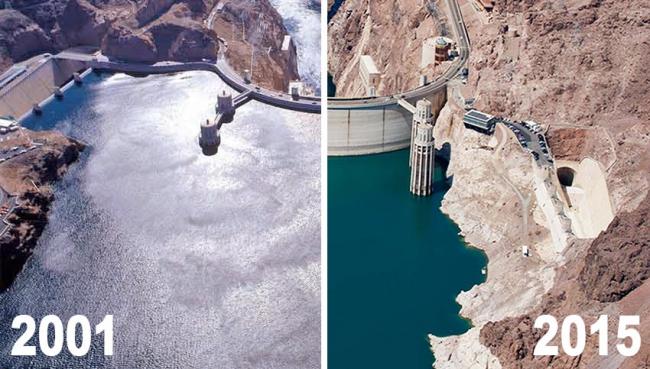Data Puzzle: Megadrought in the Colorado River Basin
In the mid-1900s two man-made dams were constructed along the Colorado River to form reservoirs (Lake Powell and Lake Mead) that could store water and provide power for the growing population in the western United States. As recently as the year 2000, these reservoirs were full of water. However, over the past two decades the water levels in both reservoirs have dropped significantly leaving “bathtub rings” behind on the surrounding bedrock - a sign of what used to be. After analyzing temperature and precipitation data, students identify the root cause of the megadrought in the Colorado River Basin and discuss strategies to reverse/reduce drought in the region.
Context for Use
This Data Puzzle is part of a larger collection of Data Puzzle resources that combine classroom-friendly datasets with Ambitious Science Teaching practices to help students make sense of phenomena!

Aerial images of Lake Mead show the dramatic decline in water levels (~143 feet) from 2001 to 2015. Photo by the National Park Service.
Goals Header
What Students Will Do
- Analyze and interpret data to evaluate the cause of a decades-long drought (megadrought) across the Colorado RIver Basin.
- Construct conceptual models to explain the cause of megadrought conditions across the Colorado River Basin.
Teaching Materials
Description
Day 1
Part 1 (20 minutes) Eliciting Students' Ideas
- Students document noticings/wonderings about drought-related images and then reflect on their own experiences with drought.
Part 2 (40 minutes) Identifying Important Science Ideas
- Students engage with an interactive reading to 1) identify similarities between the opening scenario prompt and the work of Seth Arens, a hydrologist who studies the connections between climate change and drought, and 2) make predictions as it relates to Seth's research question, "What is causing the megadrought in the Colorado River Basin?"
Day 2
Part 3 (30 minutes) Supporting Ongoing Changes in Thinking
- Students test their prediction about what is causing the megadrought in the Colorado River Basin by analyzing regional temperature and precipitation data over time.
Part 4 (30 minutes) Constructing Evidence-Based Explanations
- Students reflect on evidence gathered during parts 1-3 and construct a final explanatory model for the question, "What is causing the megadrought in the Colorado River Basin?"




